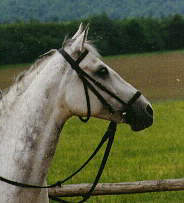
powered by FreeFind
| Main Page | Address |
| A-Z | Forum |
| German Main Page | |
|
Search
Web Search powered by FreeFind |
|
||||||||
 |
reiter.spass.com
Joy and Fun with Horses and Horseback Riding |
 |
The seat of the rider - The comunication between rider and horseThe rider's influence Ė understanding between horse and rider Ė with the correct seat.Authored by Beate Schulze and translated by Martina Wald |
||
|
||||||||
|
The seat of the riderThe correct influence of a riderís
body includes a straight line between shoulder, hip and the heel. These
three items should demonstrate a direct straight line. Between the bit, rein
and the hands are also seen as a straight line;
Of course a horse can learn hearing
the trainerís voice like Ďtrotí and Ďcanterí, but this instruction doesnít
indicate the next step. Do you want a faster working trot or a medium trot
or a medium canter? Do you want to ride a circle, go straight or turn back? For successful training I need the following items:
What does this mean and what are the reasons for these facts? Do we need a correct position to
understand each other or is there another reason for understanding and
communication? Please find out the reaction of your
body in several stages and together with your horse's, reaction after your
reaction. Riding only works if you are able to feel what the horse does. Nothing could work in riding without these feeling. Letís begin with two small journeys
One thing that never changes no matter what discipline of riding it is - be it western, English, pleasure, jumping, Kirgisian, Spain, barock art, English riding, a South American or Russia - Everybody sits directly behind the withers and in a straight position. The legs are long and bent slightlyt. The arms fall out of the shoulders without pressure. The head is straight on the neck and the eyes look straight ahead. Nobody has ever tried sitting at a horseís croup or sitting at the withers. And nobody sits bent backwards. The reasons are:
Both, horse and rider, have to find a common balance. The rider's and the horseís centre of gravity have to work in one section. Only if that fact works, a horse can carry its owner without troubles or pain. Are you not convinced yet? Well,
please take a backpack and fill it with 15 Ė 20 kilos baggage; then put it on
your back directly at the neck. That means itís situated very far above. Since the backpack is situated outside of your centre of gravity, you not only have to balance your own weight, but in addition you have to balance the backpack too, and this is an overload of certain muscle parts. This can be compared with a rider whose position in incorrect. The rider sits in a wrong position behind the withers of the horse or bent forward. The same happens if you slow down the backpack to the bottom. The centre of gravity is missed. For the horse which has its saddle not in the right centre gravity or its rider not in the correct position in the saddle, you can compare it with the backpack. Have you tested it? Probably you have failed after few minutes. Unfortunately there are a lot of riders who expect too much of the horses with such sitting faults. Our anatomy of sitting and standing Letís see how we sit and stand normally. How do we sit and stand? Yes youíre right. Normally weíre sitting and standing absolutely wrong. Itís a catastrophe for our spine, joints and muscles. Sitting and standing: Standing: Often when we stand, we stand with straightened knees and a hollow back. Only after a few minutes we begin to step from one foot to the other, because the spine is begins to ache. The body rebels, but we donít understand what it wants to tell us. Sitting: On which things we are sitting? Youíll say ďOn my bottom of course, where else?Ē Youíre absolutely right, saying this way. Please feel it by yourself. Please sit on your couch. Whatís happens? The spine bends, the shoulders go forward and we nearly sit on the last part of the bottom. For sitting we have two bones. These one sit between our two legs. Take a hard chair. Sit on the first edge and try to bring it tilting forward with your weight, so that the chair comes up over the floor. You will recognize that your spine is straight upright. Itís bringing it self into the correct position. The hip tilts forward and the head looks straight. Youíll recognise that youíre sitting on the bones. You can recognize this sitting on a hard chair very well. But on which things we are sitting all day long? We sit on the coccyx. Look at the skeleton. Sitting on the coccyx means: youíre sitting with hanging shoulders and a round back. The spine column has lost its typical s-form. The spine parts doesnít stand correctly above each others. They gape forwards. The pressure to the discs inside the spine is enormous. More than one ton of pressure can result. And now transfer this to your horse's column in trot. I donít want to be the disc which is squeezing together by every step. Test it out! So, and now please test both sitting
positions. To feel. And now the interesting part:
So, we have to be more flexible, have to move with the movement of the horse and therefore we have to use instructions (even if the movements are small) for understanding. We have to sit straight on the horse's centre so that the horse has even to balance with our additional weight (example backpack). We have also to handle the horseís movements with our straight sitting. |
| Copyright © 2003 / 2007 reiter.spass.com, Forchheim, Germany | Disclaimer of reiter.spass.com | |
|
|
||